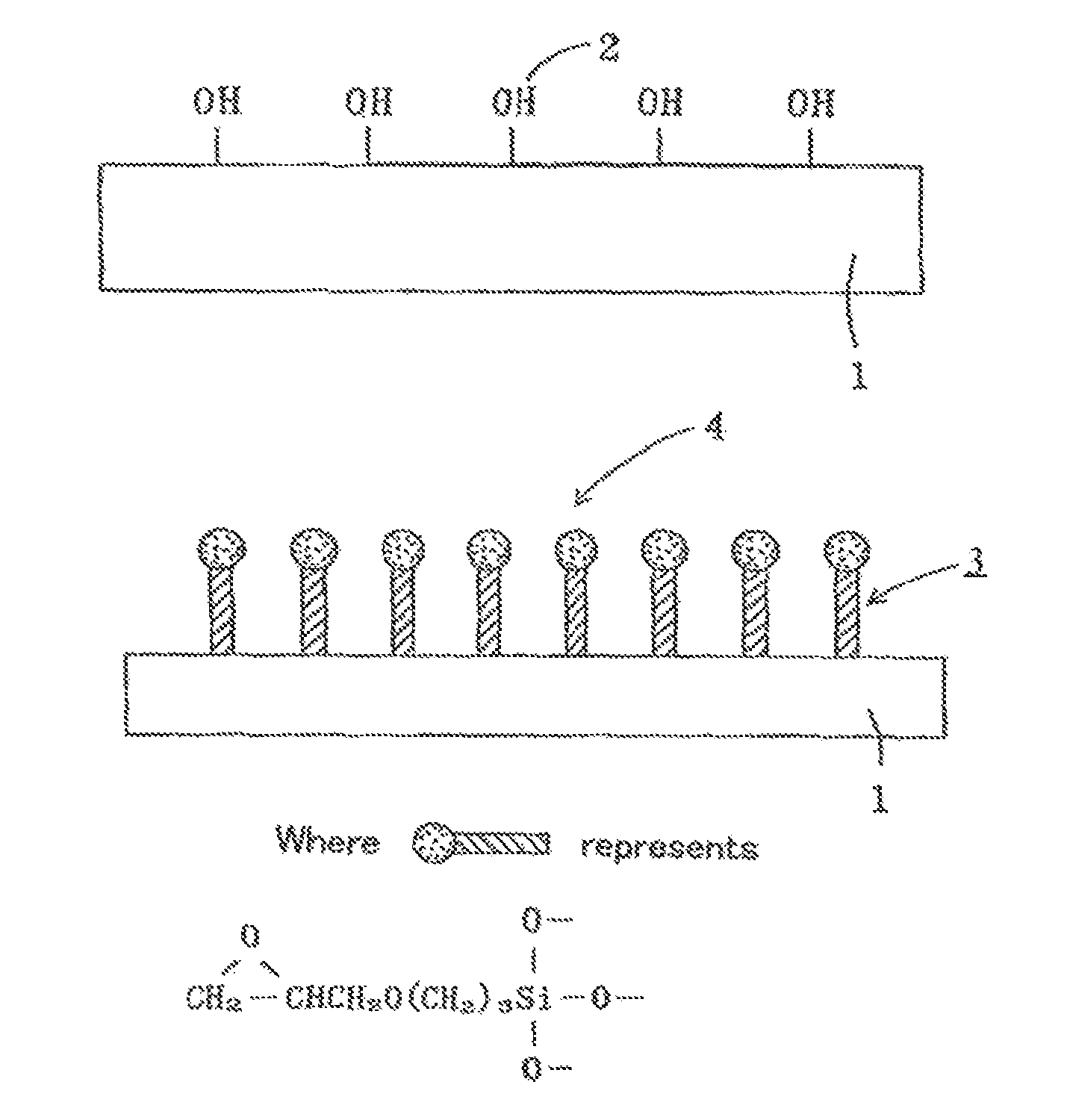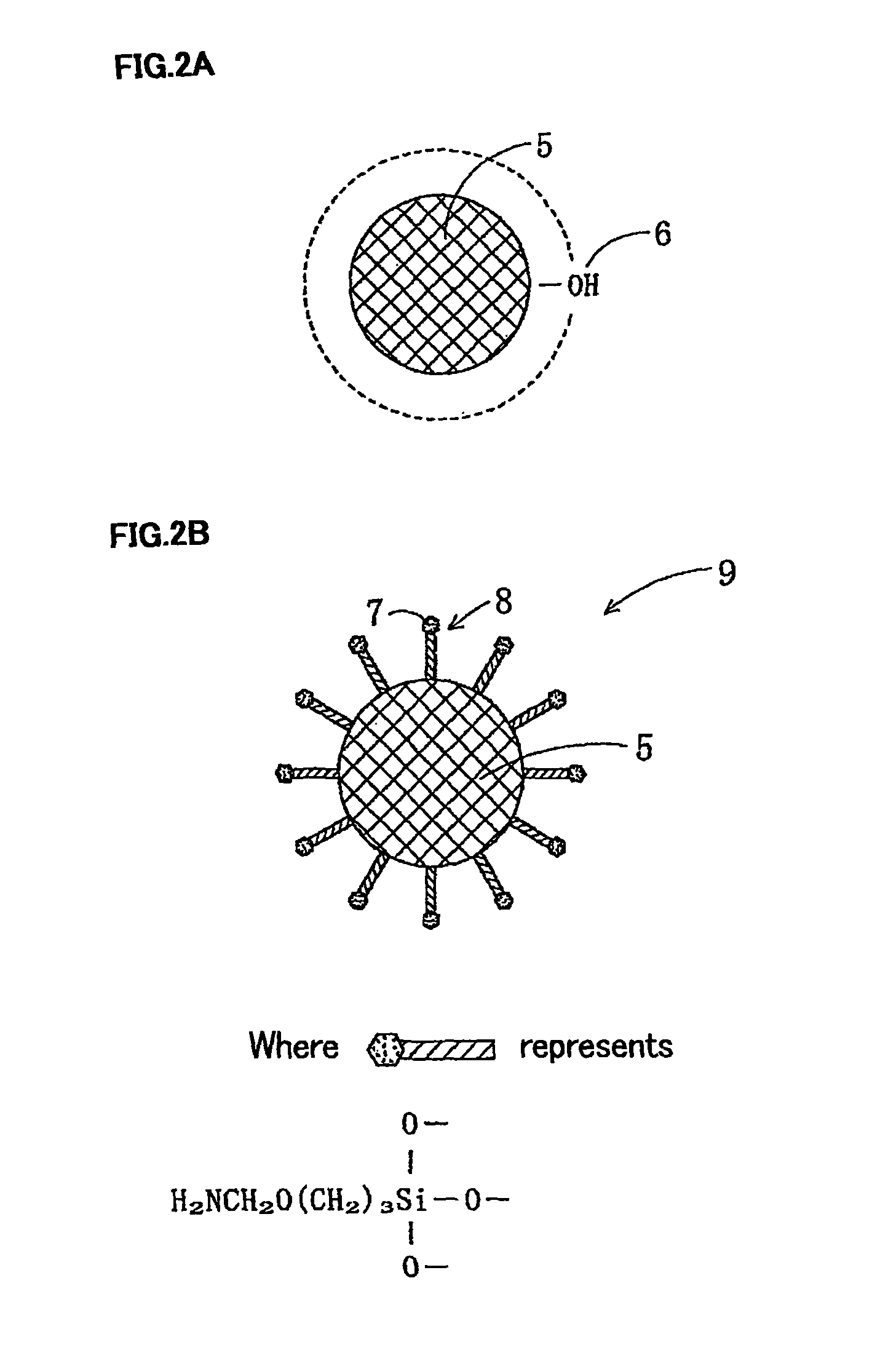Solar energy utilization device and method for manufacturing the same
a solar energy and utilization device technology, applied in silicon compounds, instruments, non-linear optics, etc., can solve the problems of not achieving substantial reduction of surface reflection of incident light, insufficient anti-fouling and water-repellency properties of solar cells and solar water heaters, and insufficient anti-fouling properties of solar water heaters. achieve the effect of improving weather resistance, improving mechanical strength of the foregoing water-and-oil-shedding coating, and short tim
- Summary
- Abstract
- Description
- Claims
- Application Information
AI Technical Summary
Benefits of technology
Problems solved by technology
Method used
Image
Examples
example 1
[0055]First, as the incident light side of the transparent base material of solar cells, a glass-made transparent base material 1 was prepared, cleaned, and dried thoroughly. Next, the second film compound containing the reactive second functional group (e.g., epoxy group) at the functional site and an alkoxysilyl group (as an example of the second binding group) at the other end (for example, the film compound shown in the following chemical formula [Formula C1]) was measured at 99 w / t %, and as a silanol condensation catalyst (for example, dibutyltin diacetylacetonate), was measured at 1 w / t %, respectively, and these were dissolved into a silicone solvent (e.g., hexamethyldisiloxane solvent) to prepare a chemical adsorption liquid so that it had a total concentration of about 1 w / t % (preferably, the concentration of the film compound is between approximately 0.5% to 3%).
[0056]
[0057]This adsorption liquid was applied to the surface of the foregoing transparent base material 1 and...
example 2
[0083]However, in Example 1, if the adsorption liquid containing CF3(CF2)7(CH2)2SiCl3 was applied to the surface of the transparent base material for reaction in the same manner, except for not performing a sintering process, since the fine alumina particles 5 on the surface of the transparent base material 4 covalently bound only in one layer via two monomolecular films were covered by many amino groups (surface groups) 7 (FIG. 3A), it causes a de-hydrochloric acid reaction between the chlorosilyl group (SiCl group) of the foregoing chemical adsorption agent and the amino group (—NH2) of the foregoing alumina fine particles to generate a bond as shown in the following formula [Formula C7] throughout the surface. Later, it was cleaned with a chlorofluorocarbon solvent, so that the plane on the incident light side was covered by a water-and-oil-shedding antifouling monomolecular film 16A (an example of water-and-oil-shedding coating) comprising the foregoing water-and-oil-shedding co...
example 3
[0087]In the same way as Examples 1 and 2, a transparent base material 10A, wherein the fine alumina particles were directly bound and fixed only in one layer to the surface of the transparent base material of the solar cell by sintering, or a transparent base material 10, wherein the fine alumina particles were bound and fixed only in one layer via a covalent bond formed between the film compounds, was manufactured. Then, after solar cell layers 12 through 15, or 12A through 15a were manufactured at the back, a water-and-oil-shedding compound containing a fluorocarbon group (—CF3) at one end and an alkoxysilyl group at the other end (for example, the water-and-oil-shedding compound represented by CF3(CF2)7(CH2)2Si(OCH3)3) was measured at 99 w / t %, and as a silanol condensation catalyst (for example, dibutyltin diacetylacetonate) was measured at 1 w / t %, respectively, and these were dissolved into a silicone solvent (e.g., hexamethyldisiloxane solvent) to prepare a chemical adsorpti...
PUM
| Property | Measurement | Unit |
|---|---|---|
| size | aaaaa | aaaaa |
| melting temperature | aaaaa | aaaaa |
| thickness | aaaaa | aaaaa |
Abstract
Description
Claims
Application Information
 Login to View More
Login to View More - R&D
- Intellectual Property
- Life Sciences
- Materials
- Tech Scout
- Unparalleled Data Quality
- Higher Quality Content
- 60% Fewer Hallucinations
Browse by: Latest US Patents, China's latest patents, Technical Efficacy Thesaurus, Application Domain, Technology Topic, Popular Technical Reports.
© 2025 PatSnap. All rights reserved.Legal|Privacy policy|Modern Slavery Act Transparency Statement|Sitemap|About US| Contact US: help@patsnap.com



